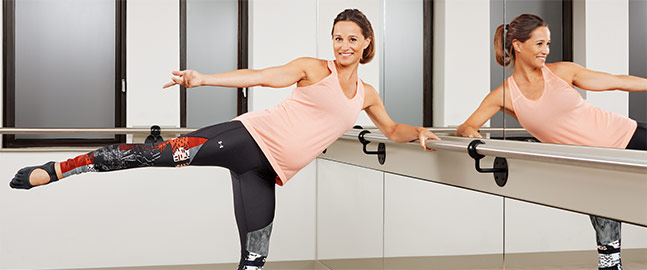
Exercising during pregnancy

With her baby due in a couple of months, our columnist faces the challenge of how to exercise in the final stage of pregnancy. Here she explains the benefits of low-impact barre workouts
As the pregnancy months roll on, keeping active – even for a sport fanatic like me – is getting increasingly challenging, but I’m determined to keep agile in preparation for labour, delivery and post-natal recovery. Besides, the third trimester is when your back and lower half take the most strain, and issues such as sciatica can kick in. So, keeping your back strong and in optimal health will help in the final few weeks.
I feel far from a ballerina, but I’m equally determined not to break into a penguin-style waddle and plod around with bad posture. So, with this in mind, I’ve continued to embrace barre-inspired workouts throughout pregnancy; a form of exercise taken from ballet which involves the small, isolated movements that develop flattering muscle tone. It’s hugely beneficial in elongating, strengthening and protecting the back and spine – plus engaging the lower body (hips, abs, buttocks and particularly the legs). It’s excellent for pregnant women in all trimesters as you mostly rely on your body weight, so it means little impact for your joints and is generally low risk.
Exercises focus on slower, more deliberate movement techniques and high repetition so you get the toned, workout effect without feeling exhausted by the end of it. I’ve included a few of my favourite barre exercises which are effective but simple to grasp, making them easy to replicate at home, or when you’re travelling, in the gym or at the park. You just need somewhere with a sturdy rail, frame or supportive chair. Treat yourself to some fancy barre-inspired socks (with grips on the feet) plus a few extra accessories to add variety to the exercises – a small soft ball, ankle weights and some light weights.
Barre requires a focused mind as some of the exercises are quite specific. With the exercises requiring a pointed leg, it’s vital to keep it as straight as possible to get the full benefits of elongation and muscle activation. Plus toning these muscles around the knee helps to prevent problems that can arise given the extra weight you are loading on them. Adding a heel lift activates the metatarsal (feet) bones and increases circulation around your ankles and calves, helping prevent swollen ankles. And barre also includes exercises that help with labour – plié squats, hip openers and engaging the pelvic floor opens up your pelvic outlet allowing more room for baby and preparing and strengthening muscles for childbirth.
The icing on the cake? I’ve heard you can continue your ballet workout once you’ve had your baby – some gyms now offer ‘barre and baby’ classes or, better still, you can live stream into classes from home. That sounds like an appealing way to rebuild your strength, pelvic floor and flexibility while bonding with your (hopefully) happy baby!
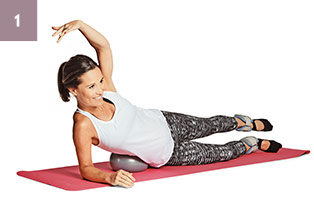
Side leg raise
(Reps: 20 each side)
Benefits: Works your core, inner and outher thigh, glutes and triceps
Start by laying on your right side with both legs out straight and your left leg resting on top of
the right. Using your right elbow and a ball placed under your ribs to prop you up, engage your left glute to lift your left leg into the air. Pause at the top for a few seconds then lower back down again, ensuring your ankles don't touch each other.
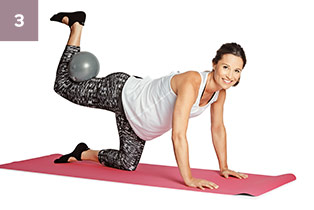
Side leg raise
(Reps: 30 each leg)
Benefits: Works your glutes, hamstrings and core
Kneeling on all fours with your hands underneath your shoulders, and knees underneath your hips, place a ball (or rolled-up towel) behind your knee, and hold it between your hamstring and calf. Keeping your back and hips still, push your heel towards the ceiling, then lower. Repeat 30 times – pulsing the leg up and down without letting go of the ball, while keeping your head in line with your body looking at the floor.
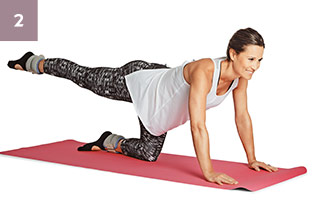
Kneeling glute leg raise
(Reps: 30 each leg)
Benefits: Works your glutes and core
Start by kneeling on all fours with your hands underneath your shoulders, and knees underneath your hips. Extend your left leg straight out behind you with your toes resting on the floor. Keeping your tummy muscles tight and back straight, lift your leg up until it's level with your hips, then lower back down to the floor and repeat until you have done 30, then switch sides.
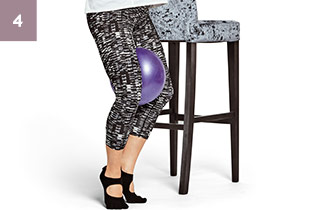
Narrow 'V' with ball squeeze
(Reps: 50)
Benefits: Works your inner thighs, glutes, calves and core
Start with either one or both hands on a sturdy object such as a chair, with your heels together and toes apart in a narrow V – or ballet-first position. Lift your heels off the ground and bend your knees creating a diamond shape with your legs. Place the ball between your inner thighs and squeeze in on the ball. Start pulsing down an inch and up an inch. Pulse for 50 reps – squeezing the ball as hard as you can.
Up to 80% of pregnant women suffer from lower back pain associated with the ever-increasing weight of the uterus, making it more important than ever to work on core strength and stability during the third trimester. The increased pressure on the hips can also lead to pelvic girdle pain (PGP) – in the past, mums-to-be suffering from PGP were advised to rest, but we now know that movement and exercise can help reduce pain and improve mental and emotional wellbeing as the delivery date approaches.
Pippa’s choice of barre exercise provides a fabulous stimulus for core strength and stability in a safe, supported environment. It also works the pelvic floor making it easier to relax during delivery, reduce stress incontinence, and accelerate recovery post-delivery. Maintaining aerobic and strength endurance through exercises like these (and swimming, which we know Pippa loves) in the final few weeks will help during delivery, particularly if labour is prolonged. However, it’s important that Pippa avoids over-stretching as her joints will have begun to relax in preparation for delivery.
Now the baby is not only heavier but longer it can press up against the diaphragm leading to an increase in breathlessness, particularly during activity, and sometimes can make exercise a chore. But that’s not a reason to take it easy! Exercise can increase energy levels, reduce pain and improve mental and emotional wellbeing.
Pippa’s proactive approach to pregnancy and her fitness will provide significant support during the post-partum period and beyond, and her active lifestyle not only provides a wonderful role model for her baby but could potentially contribute to its own healthy future.

Try to keep moving, even if you're tempted to sit back and 'rest' – gentle core and strength aerobic exercise will help prepare you for labour,
improve your overall wellbeing and help
your post-delivery recovery.

Continue with those pelvic floor exercises –
you'll reap the benefits in the long term.

The increase in the hormone relaxin leads to joint laxity in the third trimester, ready for labour. This isn’t the time to over-extend during a workout – keep movement gentle. Swimming is ideal as the water provides support.

A little increased breathlessness is normal now, particularly during exercise, thanks to the baby's increasing presence pressing on the diaphragm, but if in any doubt consult your GP.



